U-47 continued to patrol out of La Spezia in the Mediterranean through the summer of 1943. Unless we sail east of Crete we are finding no lone merchants. But convoys come along frequently, and maybe I was fortunate, or maybe I've learned how to attack convoys in Operation Monsun. Regardless of the reason, U-47 had great success in getting inside the screens and putting torpedoes on target during patrols sixteen and seventeen. Our Biscay Cross continued to be the most valuable installation on our boat. Time and again, it's warnings were quickly heeded, and we managed to avoid attacks by the many air patrols that were encountered. On one or two occasions the aircraft dropped their ordnance, but we were already heading deep and their attacks were ineffectual. On the whole though, the Cross allowed us to avoid detection.
In addition to aircraft, it also gives bearing to radar equipped escorts, which allowed us to essentially home in on the signal, and get below the surface before we can be detected. For whatever reason, the dive time upon ordering periscope depth in OM is excessively long. And this is with a highly experienced crew, and with quite a few diving experts, crewman who have attained that special ability. So my procedure is to order crash dive, then order periscope depth upon reaching 10 meters. This has the effect of leveling off right at the proper depth and we can get under in very short order.
Patrol 16 left La Spezia in the early hours of May 9, 1943, loaded with a full complement of TIII electrics. I had hoped to have available some G7e/T4 'Falke' acoustic homing torpedoes by now, but none were available. I would like to load all forward slots with TIIIs and all after slots with Falke for defense against searching escorts, but that will have to wait. This was my preferred late-war loadout in SH3, and proved very successful.
Our patrol grid was once again off the Algerian coast, and for what it's worth, every Med objective in this career has been off the Algerian or Moroccan coasts. Several contacs with convoys were developed, and we were able to create enough of an advantage to get in on two of them. The first was found with the help of aerial scouts running the route from Alexandria to Malta. Slipping inside the portside screen in very heavy seas, U-47 torpedoed the first Liberty ship we have seen from the point-blank range of 400 meters.
Here the first of the two torpedoes fired at this ship strikes MOT, below the stack
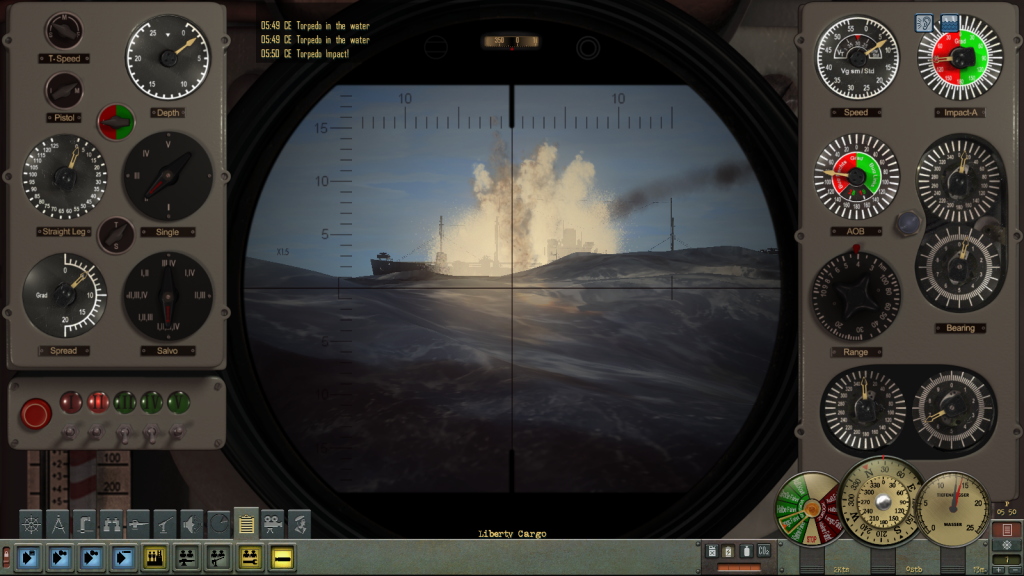
As we pass astern in search of the next target, a quick look at the Liberty shows her with a severe down-angle with her ensign flying.

These shots hint as to the challenge of attacking targets in heavy seas. Those who have followed any of my posts know I play without external cameras. And it's not just to blow my horn, but to emphasize the fact that playing Silent Hunter this way fundamentally changes the way the sim is played. The first screenshot above shows what was probably my clearest look at this target. When the seas are rolling, and your view is restricted to 6 inches above the water, you are presented with very brief snapshots of the target ships as they appear and disappear through the swells. And moreover, riding out evasions from within the control room or conning tower is far more challenging than when you can watch the escorts from above the water and react to what they do. Once your scope goes below the surface, you are blind, and it changes the way you think, what you know, and the decisions and actions you take. Something as simple as checking a box in the difficulty menu has a profound effect on how you approach the game and the decisions you will have to make.
After sinking the Liberty, U-47 continued at ahead slow looking for another target to appear in the glimpses through the troughs. But what we saw was a destroyer coming on with a bone in her teeth and I ordered crash dive as she began a short-scale ping. As we passed through 70 meters, a string of depth charges landed close aboard, causing moderate damage and U-47 sprung a few leaks.
Here you see the control room of U-47 with some leaks that have not been fixed.
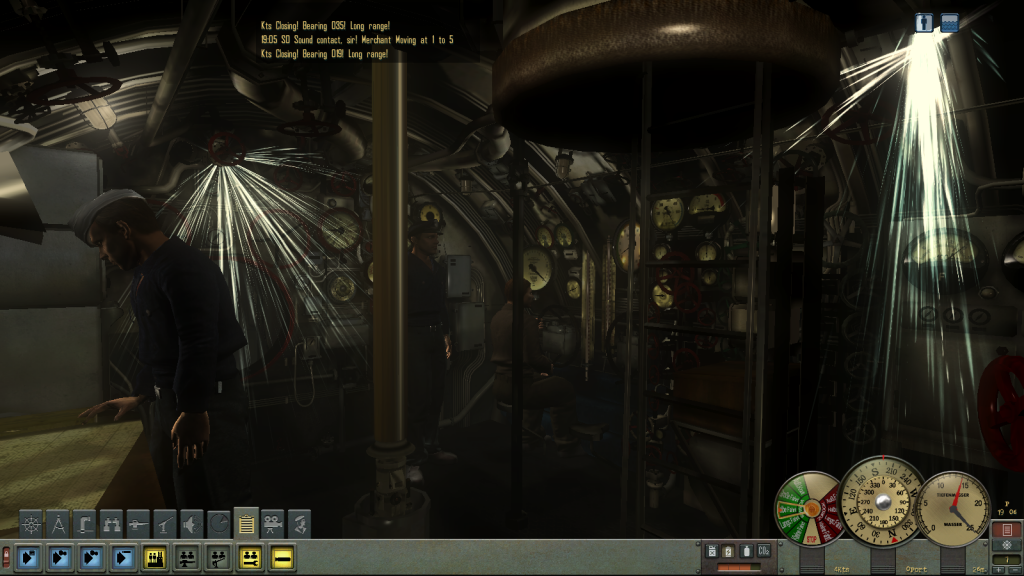
As mentioned in earlier posts, the crew of U-47 is highly experienced. Every crew member has been promoted several times, and all have specialties, and many have Special Abilities. With such a crew, repairs are often quickly made, and here too, and we sought safety in the depths, hoping we would be lost in the many merchant screws above. We kept going down to 160 meters, and the combination of this depth, the sea state and the many screws in the area all allowed U-47 to slip off to the north and evade successfully as the destroyers lost track. After all screws were lost on the hydrophones to the west, we returned to periscope depth. A quick look revealed nothing in sight, and we surfaced and headed north to the waters between Crete and Cyprus that proved so lucrative in our early forays in the Med.
Over the next 2 or 3 weeks, we made contact with several merchants steaming alone. We managed to put five on the bottom, 2 of the small 1800-ton M-KF-F freighters, and three of the medium M-KF-M (E) freighters of 5000 tons, all of which flew Turkish flags.
With fuel dwindling and torpedoes running low, U-47 set course back to the west to patrol the bottleneck between Sardinia and Tunisia. Only July 3, we again contacted a convoy with the help of the Cross, and managed to slip inside the screen of very modern DDs and DEs. Once inside, we torpedoed two more freighters of 9000 and 5900 tons and evaded the searching escorts. Out of torpedoes, U-47 ran for the barn and put in to La Spezia on July 9, after exactly two months at sea, having sunk 7 ships for 35,745 tons.
During refit, U-47 saw the installation of a new decoy, Bold 1, which is a canister of calcium hydride that can be ejected from the submarine, and when mixing with seawater, produces a large cloud of hydrogen bubbles to provide a false sonar target for searching enemy ships.
U-47 left La Spezia for the last time on August 15, 1943 on her seventeenth war patrol, again bound for the waters off the Algerian coast. Soon after departure, we received a radio message to shift base to Toulon, located a short distance to the west on the French coast.
Several days after arriving on station, and having dived many times to avoid prowling aircraft, the Cross once again alerted us to the presence of a radar-equipped enemy warship. We homed in and dove in a raging storm, heavy fog, 15 m/s winds and heavy seas. Visibility was around 1500 meters. In what would become on of my most successful convoy attacks ever, U-47 sank 5 good ships in 30 minutes. The storm and the sea state seemed to prevent the enemy escorts from being able to find our boat as we fired torpedo after torpedo at ships that emerged from the fog. The first two fish were fired at an 8300 ton tanker. But something wasn't right with my setup, and the first torpedo missed ahead, and the second struck the tanker, damaging it, but she kept on. Fortune was with us, as the torpedo that missed continued on to strike a ship in a far column, a 4100 ton freighter that blew up and sank. Because of the fog, this was out of our view. Two 5100 ton cargo ships went down in short order, as we fired torpedoes as soon as they were reloaded as the convoy paraded past, seemingly unable to determine where the attacks were coming from.
Another big tanker of 8500 tons hove in to view and this ship too was sent to the bottom, having broken in two after being struck by our second torpedo. Soon after, the tanker that was the first target went down. In a half hour, five enemy ships for 32,860 tons went to the bottom of the Mediterranean.
Here the second tanker settles having broken in two
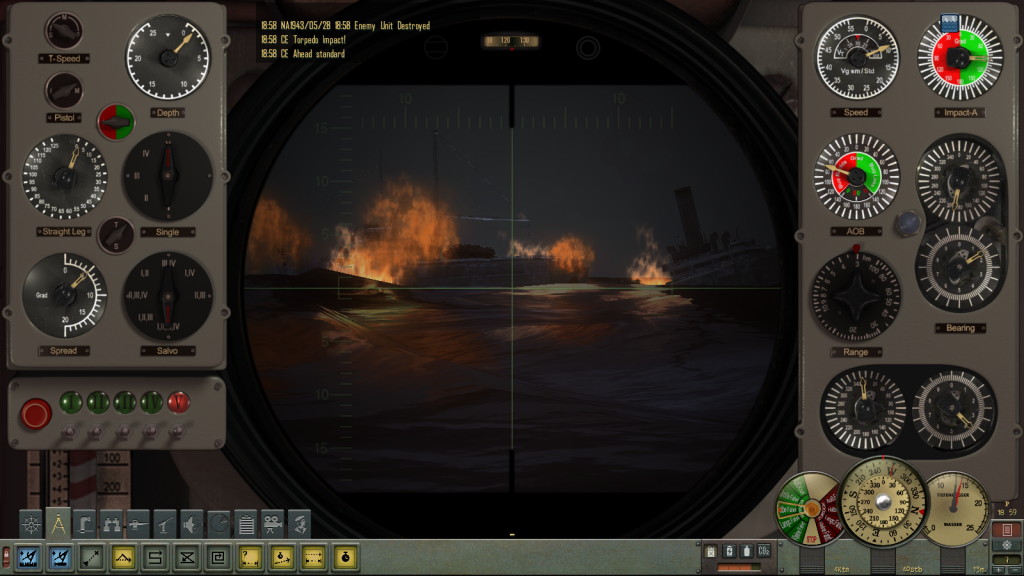
After the two tankers went down, we dove deep and slipped away, with distant pinging heard for a long while afterwards. Finally clear of the screws, U-47 surfaced to exchange the air and recharge the batteries. Several weeks went by, and the weather turned clear and very calm. Again and again, we dove to avoid aircraft. Two more convoys were contacted, but experience has proven that attacking in calm seas hands the initiative and advantage over to the enemy escorts. Unable to find a clear opening, I elected to run away. Keywords discretion/valor. In the second of these convoys, I had noticed a Bogue Escort Carrier sailing in it.
I've now done 17 patrols in OM. If there is one key I have found to success, it is sea state, sea state, sea state. For anyone else playing this mod, all I can say is that sea state is the most important factor in getting in on escorted enemy formations. From the surface attacks I was doing in '41, to getting in submerged on the convoys in this post, heavy sea state is the key. Attacking escorted formations in calm seas is asking to be sunk. Bide your time, and take advantage of heavy weather when the opportunity arises.
On September 5, with the weather having turned once again, U-47 made contact with a convoy about 100 kilometers east of Algiers. I attempted to home in on the radar signals, but by the time I was able to sight the convoy, it was evident we were trailing, and they had gotten by. We surfaced , extended away to the south at flank speed. I plotted the convoy's course, and made a flank speed dash for 150 kilometers to the west, turning back in on the course after having dived for aircraft many more times. I would like some stock in the Metox company

Once positioned near where I expected the convoy to come on, we waited. Before too long, the convoy was detected on the Cross and then on hydrophones, but tracking the hydrophone bearings revealed I had dived a little too far to the north of their present track. Turning around, we moved cautiously at ahead full to close the track and get a shot in. Again, we were able to penetrate the screen and get inside the enemy formation.
As the ships came on, I began identifying them and looking for big ships. After choosing a likely target and plotting the convoy's 6 knot speed, I prepared to fire. Just before pushing the plunger, I saw a carrier emerge from the fog.
Here is the convoy and U-47's position relative to the Escort Carrier when first sighted.
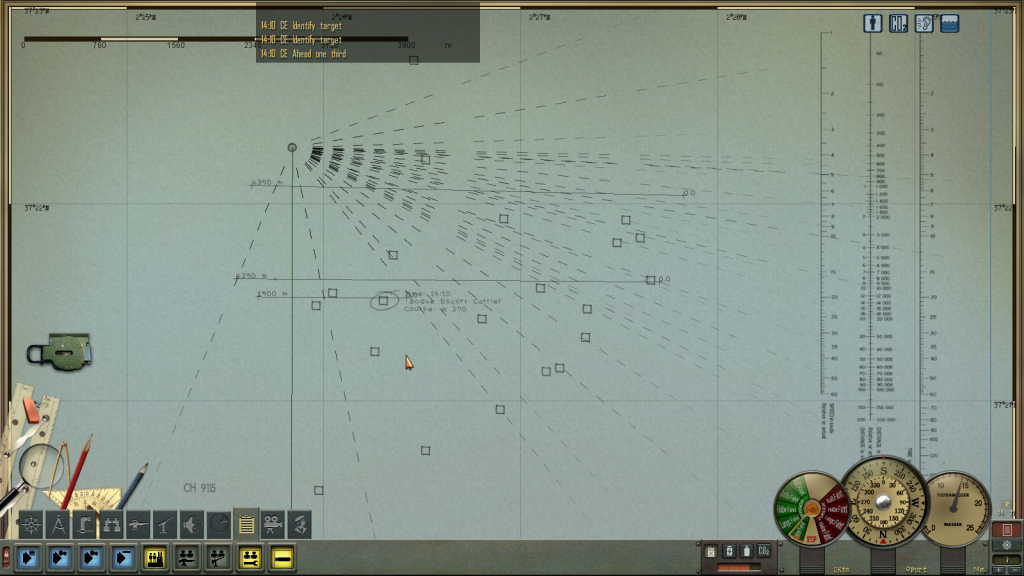
This convoy is scattered I think in part due to the heavy seas, and in part I believe due to the fact that the escorts had detected me on radar a few times as we made the 150km flank speed end around, causing the ships to zig and as a result, their station keeping went astray.
Here is another shot that shows how heavy seas affect the ability to track targets.
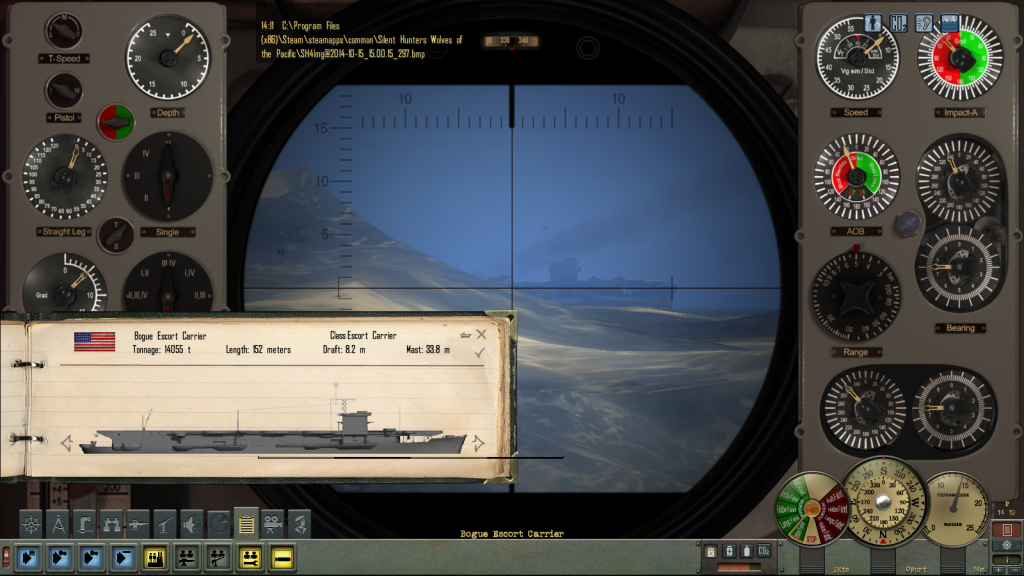
Here is a good look at the Bogue 10 degrees before firing

That screen shows the setup just before firing. The solution has been dialed in. Looking at those dials, we can see a perfect setup, assuming I have the speed and range correct. You can see the speed at 6 knots. The 'Impact A' dial, shows the expected impact angle of the torpedoes, which is an ideal 90 degrees starboard. AoB is set to 80 starboard, since U-47 is on a course 90 degrees to the target's course and the bearing is set to 350, which subtracts those 10 degrees from the 360 degree bearing which intersects the target's course at 90 degrees (when precisely heading on a 90 angle heading to the target's course, AoB and scope bearing are easy to determine. If you place the scope 20 degrees from 360/180, you know the AoB is 70. If at 10 degrees from 360/180, AoB is 80 and so on). Range is 1400 meters. And the gyro angle is 000, which all adds up to a perfect torpedo shot.
As the carrier crossed the wire, three torpedoes were fired, at intervals to spread the torpedoes along the length of the target. Looking at the left side of that screenshot you can see the torpedo settings. I have all four bow tubes opened and depth set very shallow, 1.5 meters. I have set the pistols to impact to eliminate the chance of prematures in the rough seas. Each fish is fired single in accordance with the procedures and thinking outlined in previous posts, so the salvo options are unused.
All three torpedoes hit the carrier and detonated. Fires were visible, but she didn't immediately appear to be sinking.
Here the second of the three torpedoes strikes below the superstructure.

I suspected that the three hits would be enough to cause this carrier to eventually sink, but taking no chances I fired the 4th bow tube on a 010 track, which would cause the torpedo to approach abaft the beam, but this torpedo hit and exploded, and so did the carrier. You can see I adjusted the speed and range down slightly due to expected slowing of target after hits and having closed somewhat since the last shots. Note the change in the 'Impact A' dial.
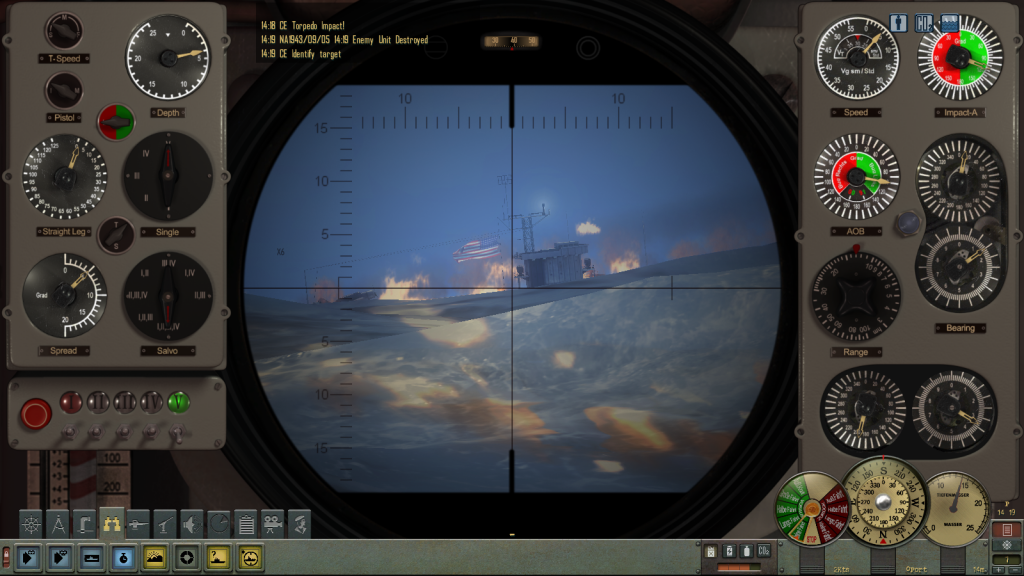
I fired the last bow tube and the last stern tube at two more ships, but both of these torpedoes missed, probably due to the ships turning away after being alerted by the demise of the Bogue, or perhaps I just got it wrong.
Out of torpedoes, U-47 headed for the barn, putting in to Toulon on September 7, having sunk 6 ships for 46,915, after a relatively short three weeks at sea.
I am very pleased with these two patrols. Making that many successful attacks on convoys well-escorted by the latest in American destroyer hardware is very satisfying indeed. The success is due, I think, in large part to choosing to attack when the conditions were relatively favorable, and knowing when the setup wasn't right and sailing away to fight another day.